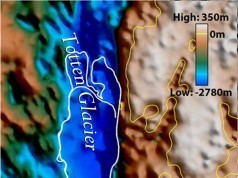The head of the IPCC has written a novel in which the central character is infatuated with pseudoscience and in which UFO enthusiast Shirley MacLaine is presented as credible. The final installment of the Nobel Laureate Summer Reading series.
Rajendra Pachauri, the chairman of the Intergovernmental Panel on Climate Change (IPCC), is the author of a novel, Return to Almora. In 2010, it was published to great fanfare. One of the world’s largest banks – HSBC – was an official sponsor of the gala book launch in Mumbai.
Later that year, Pachauri downplayed media reports that his book is a racy read. “I’m happy to send you a copy if you have the patience to go through it,” he told a reporter, “but it’s 400 pages all about spirituality.”
This journalist has now read those 400 pages. It turns out there’s a considerable gap between what the author says his book is about and the evidence on the printed page.
The novel recounts one person’s life journey – from early childhood until “almost sixty.” The protagonist is an Indian-born male named Sanjay Nath. Throughout this work, we’re assured again and again that he is special – and that he “longed for people to look up to him, to recognize his true worth, to admire him.”
Not only is Sanjay a precocious youngster, in his final year of high school he wins the overall “class prize” as well as the “prizes for English, Hindi, physics, chemistry and mathematics.” He’s “at the top of his class,” during his engineering studies, and comes first in the entire state “in his intermediate exams.”
Friends, acquaintances, and lovers shower him with praise: “You are destined to become a great person,” they say. “The world will, one day, recognize your talents.” To each other, they solemnly observe that “He has something deeper than a strong intuition. It is truly a rare gift.”
Girls are “dazzled by his brilliant teachings” and at least two of them tell him he’s a “saint.” A friend describes him as “very bright.a genius.also very spiritual,” and his inlaws regard him as “a personification of perfection, righteousness, and decency.”
He is advised, more than once, that he is “a great soul.” If all of that hasn’t left you retching, a US senator declares publicly that Sanjay is “the most selfless and enlightened human being living in the world today.”
Sanjay’s US-based business empire takes the form of a chain of meditation centers. We’re told they’re highly successful and that he spends his time
attending conferences and delivering speeches around the world. More and more people began to benefit from his wisdom and teachings. His fame spread, not only in America but also in other countries.
On one occasion, he inaugurates the opening of a Hindu temple in West Virginia. We’re supposed to believe that a news report about the event contained the following paragraphs:
His speech, which a large audience heard with rapt attention, was for all those present an experience of a lifetime. His style of delivery is as appealing as his words are inspiring. Here is an extract from his sermon:
‘Human existence is a gift from the universe and from god. It is the bounty that comes from the confluence of many streams flowing into a lake. Life is a vast lake, bounded on all sides with the rich loam of fertile land and abundant greenery. From the surface, you can never tell the depth of the water. It is for us to explore the depth of what we have with the best instruments at our command. We must believe that we have the ability to direct the flow of the winds that come at us, and we can also convert the gusts that shake up our lives into a smooth and steady movement. We can, therefore, ensure that every influence on our life passes by safely, without creating the effects of a severe tempest.’
In his writings and speeches, Nath, an erudite scholar, attempts to relate philosophical thought to the realities of everyday life. Some regard him as a modern-day Gandhi.
Only in a cardboard cutout world would a journalist describe a speech as “an experience of a lifetime” for “all those present.” Reality is not what’s being depicted here; this is an elaborate, infantile fantasy. The narrator informs us that
Sanjay was deeply inspired on the occasion [of the temple inauguration] and spoke with an eloquence and brilliance that transcended even the highest standards he had established in the past. The audience was spellbound and ecstatic, giving him a standing ovation that lasted a long time. He was mobbed as he tried to leave the venue.
But because the news report has provided a snippet of Sanjay’s sermon, we are able to judge for ourselves. Rather than being brilliant, his utterances are banal. Which is the central problem of this book. An author can declare, ad infinitum, that people admire his central character’s “wisdom and teachings.” He can have a reporter compare that character to Ghandi. But even in fiction, the reader must be persuaded – and little in this novel is persuasive.
As a young Hindu, Sanjay thinks about life’s great mysteries – and wonders how the soul passes from one body to another during the process of reincarnation. He consults a couple of swamis, visits a few sacred locales, and later, as a result of his meditation fame, comes to be regarded as a spiritual leader in his own right.
What kind of spirituality? The sort associated with Hollywood actress Shirley MacLaine – who appears as a character in this novel, voicing lines written by Pachauri. These days, MacLaine is famous for her outspoken views about extraterrestrial life. According to a recent article on Oprah Winfrey’s website, MacLaine has
seen many UFOs from the deck of her New Mexico property. “I’ve seen a mothership here, and I’ve seen them at my ranch,” she says. “One famous day, a friend of mine was sitting in my hot tub out there, and three UFOs came over and hovered over the hot tub for about 10 minutes.”
.Shirley says that she believes extraterrestrials are attracted to the many crystals around New Mexico. “Crystals amplify the consciousness,” she says. “They’re attracted to that crystal amplification.”
She says she has never seen an alien but says their teaching is that the soul does not die. “The soul is everlasting, and its learning experience is lifetime after lifetime.”
In the novel, MacLaine’s ideas are not ridiculed. Quite the opposite. Sanjay treats her as an intellectual equal and takes her advice. While she doesn’t mention UFOs specifically, she urges Sanjay to travel to Peru:
You won’t believe the spiritual richness of that land. God does not reside above in that place. He has actually descended on to the mountains, and you can feel his presence everywhere.
When Sanjay and MacLaine meet for dinner in that country, we’re advised that a member of her entourage is “known to communicate with the spirits.”
One of Sanjay’s academic mentors studies the “psychic vibrations” of industrial workers, and believes that spiritual development affects productivity. We’re told that Sanjay
wished he were working full time on this parapsychology thing. It went to the core of all that he believed in and excited him no end.
What is parapsychology? So glad you asked. This is the realm of “telepathy, clairvoyance, psychokinesis, psychic healing, and precognition” – aka full blown pseudoscience. Reputable scientists make fun of these ideas. Some regard them as dangerous, and feel a duty to debunk them.
Late in the novel, we stumble across this subheading: “Science and the human soul.” It appears in the midst of Sanjay’s visit to a Tibetan monk named Lama Nado Dorje.
We’re told that Dorje is thought to “possess extraordinary clairvoyance.” At his research facility on an arctic island well north of mainland Norway, Sanjay witnesses firsthand
the experiments [Dorje] was carrying out using a device called a transcranial magnetic stimulator. This was fixed on the heads of his students and produced magnetic currents that created a sensation of being in the presence of god.
.Dorje asked [the student] to rate on a sheet of paper, how close he had felt to god on a scale from zero to [a] hundred.
This less-than-rigorous “experiment” – based on how people think they feel – is conducted again, after a flight takes them even further north. On the first occasion, the student subjectively indicated a score of ninety. The second time around,
Julio’s face lit up with intense joy two minutes after the experience, and this time he scored 97 on a scale of 100, registering his connection with god during the experiment.
‘I told you so,’ said Lama Dorje triumphantly. ‘This isn’t the first time that scores in this place have been higher.It proves that there are locations on this earth that are far more receptive to communication with god than other places.
Pseudoscience. That is the fictional territory Pachauri has chosen to explore. He says he has written a novel about spirituality. Instead, he has given the world reason to wonder whether the man in charge of the UN’s climate body can tell the difference between sound science and junk science.
Overall, this is a wretchedly-written, atrociously edited work. The Kindle edition contains scores of typos. Moreover, in the opening chapter, we meet a woman named May. She tells a stranger that she and Sanjay “are not married.” Since we’re still finding our bearings in this fictional world, we believe her. Much later, it becomes clear that that scene is part of their honeymoon visit to India.
Following May’s sudden death, Sanjay believes she continues to speak to him. But there’s a twist – she wants him to sleep with other women. After an individual named Otelia throws herself at Sanjay for the second time in Norway, we’re told that May
seemed to appear before his very eyes. “Go for it Sandy. I want you to,’ May’s image said impishly.
On another occasion, he wakes in the middle of the night and feels May’s presence: “Sanjay, Pooja still loves you. Why don’t you make her yours?”
Sanjay is supposed to be unusually perceptive. His great gift, we’re told, is “something deeper than a strong intuition.” Yet he has no idea that a friend is suicidal.
When that friend is hospitalized after shooting himself in the head, the nurse warns them that his appearance may come as a shock. As his chum’s life ebbs away
Sanjay decided not to go in [to the hospital room]. He wanted to remember Ramesh just as he used to be.
Excuse me? Your friend is on his death bed. Rather than being physically present and supportive at his moment of great spiritual transition, your overriding concern is aesthetic?
This is a novel in which “crass materialism” is tediously denounced, and in which the spiritual power of Nature is extolled. Yet, when Sanjay visits Niagara Falls, that majestic natural wonder makes no impression on him. The novel treats it as a non-event:
Their hosts had arranged a trip by car for them to the Niagara Falls. This still left Sanjay with a day and a half of free time. He decided to phone [an old friend].
As I have observed elsewhere, many readers will remember this work for non-spiritual reasons. The same narrator who felt no need to utter a word about Niagara Falls told us a great deal about other natural wonders – namely, women’s breasts.
According to an electronic search, they get mentioned on 18 separate occasions. They are described as “voluptuous,” “full and firm,” “small,” “heaving,” “shapely,” and “generous.” It’s no accident that Sanjay’s 20-years-younger-than-himself wife refers to herself as “busty.”
Perhaps, therefore, it’s fitting to close this five-part exploration of Return to Almora with the following example of the IPCC’s chairman’s towering literary talent:
She had voluptuous breasts, which Sanjay just could not let go of.She was really moist and made delirious sounds as they made love.
see also
Nobel Laureate Summer Reading – Part 1
Nobel Laureate Summer Reading – Part 2
Nobel Laureate Summer Reading – Part 3
Nobel Laureate Summer Reading – Part 4
Mea culpa. The original version of this post misspelled Ms. MacLaine’s surname.





